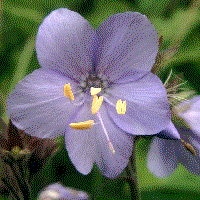 |
POLEMONIACEAE - The Phlox Family
This is a family of only about 300 species, mainly from North America, but also from other parts of the northern hemisphere and the east of South America. It includes plants of all types and sizes, from trees to small annuals. Several species are grown as garden plants, including Phlox, Polemonium and Gilia. The tropical members of this family (Cantua, Cobaea, Huthia, Loeselia, Bonplandia) are mostly woody plants with large flowers and winged seeds. Those from the temperate regions are mostly herbaceous with small flowers and wingless seeds. |
CHARACTERISTICS OF THIS PLANT FAMILY:
Leaves, Stem & Roots: ~ Leaves are alternate or opposite, and may be undivided or compound (made up of many leaflets). The calyx is made of five parts, fused into a tube. The leaves are sometimes covered in short hairs, making the leaves appear sticky.
Flowers: ~ There are five petals, joined to form a flat round or bell shaped flower, and five stamens joined to the flower tube. They may be single or in small clusters, either from the leaf joints or at the end of the stem.
Seeds: ~ The seed pod forms inside the flower. It usually has three parts joined to form a pointed capsule which splits into three parts to release the seeds. There may be one or many seeds, and they are often sticky when wet.
Members of this Family usually have:
Five joined petals
Five stamens
Calyx made of five parts joined into a tube
Alternate or opposite leaves
Seed pod with three chambers forming inside the flower
Sticky seeds
and are perennial or annual deciduous plants